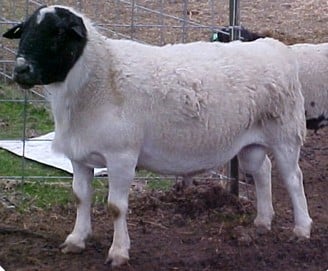The Dorper is a breed of sheep that originated in the south of Africa in the 1940’s. It is the product of cross-breeding between the Dorset Horn and Blackhead Persian breeds. Dorper sheep have a distinctive appearance: black heads and white bodies.
The breed has a thick, well muscled carcass and extended period of fertility. Dorset ancestors are responsible for the latter trait. Today, the Dorper is an abundant and popular breed which has earned a reputation for strong mothering instinct.
Why Raise Dorpers?
Dorper sheep are highly adaptable to a variety of climates (as are most hair sheep breeds) and has gained popularity due to its resiliency and hardiness.


Dorpers can be found in climates ranging from hot to humid to cool and dry.
Though Dorpers do have wool in addition to hair covering their bodies, they do not need to be sheared – a trait which is popular for many shepherds who consider wool production an expensive annual enterprise.
Typically, the Dorper breed can survive on different qualities of feed. They aren’t picky eaters.
Dorper lambs have earned a reputation for maturing quickly and this rapid development makes the Dorper breed an ideal choice for spring market lambs.
The sheepskin of the Dorper is the world’s most prized and the high-grade, muscular carcasses of this breed makes Dorpers a natural choice for commercial production farms.
Dorper Sheep Size
| Mature Ram Body Weight | 220 – 250 pounds |
| Mature Ewe Body Weight | 170 – 200 pounds |
Dorper Sheep History
As stated earlier, the Dorper sheep can trace its roots back to South Africa. This breed was developed with one goal in mind, that is, to produce premium-quality mutton for sale in London’s prominent Smithfield Market.
When South African farmers first exported mutton and lamb to this market, the traders rejected their carcasses. According to the traders, the meat – which the farmer’s had gotten from their fat-tailed indigenous sheep breeds – was low-quality. It just wasn’t as good as the New Zealand Canterbury lamb meat that European consumers were used to.
Not wanting to give up on their quest to export mutton and lamb, the South African Meat Board decided to go back to the drawing board.
They began experimenting with different breeds of sheep. Their aim was to come up with a breed capable of producing high-quality carcass under the tough arid and semi-arid conditions of the Northern Province.
A Successful Cross-Breeding
After years of trying, they finally came up with the Dorper – the result of crossing the Blackhead Persian and the Dorset Horn. The Blackhead Persian was selected as the mother breed for its capability to withstand harsh climatic conditions. Meanwhile, the Dorset Horn was chosen for its longer breeding season.

The breed experimentation project concluded in 1946 with the Dorper earning a respectable spot in the history of the South African animal husbandry. So much so that four years later, the South African Dorper Breeders’ Association was established.
Shortly after the Association was formed, a debate regarding the black markings vs. purebred white Dorper. For some breeders, the white variety – called the Dorsian – was the real deal. But for others, the black markings on this breed served as a trademark trait.
Thankfully, this dispute was resolved in 1964 when the blackhead and white Dorper breeders joined forces. They created a single association and chose to give distinct names to each variety. The blackhead was called the Dorper whereas the unlabeled sheep was named the White Dorper.
Today, the Dorper is the second most popular breed in South Africa averaging a population of 10+ million. More importantly, this breed has spread to other parts of the world, including the United States, South America, Canada, Mexico, the Middle East and China.
Dorper Sheep Characteristics
When it comes to physical traits, the Dorper is easy to identify using its mid-sized, barrel-shaped, hornless profile. It’s moderately long with just a light covering of hair and wool. In terms of color, expect it to have a black head for the Dorper and a white head for the White Dorper.
Another distinct trait of the Dorper sheep is its thick skin. This is what protects it from the tough climatic
Character-wise, this breed is revered for its extreme hardiness and easy adaptability- traits obtained from the Blackhead Persian used in its cross-breeding.
Frequently Asked Questions about Dorper Sheep Breed
Still have some questions? Here are some answers to a few of the most common questions I receive about Dorper:
How long does it take Dorper sheep to mature?
Another fun fact about the Dorper breed is that it’s extremely fertile. Under ideal forage conditions and proper management, their ewes can lamb a maximum of three times within two years. This means their lambing interval lasts for only 8 months, which is relatively short compared to other breeds.
How many lambs can a Dorper ewe have in a year?
Another fun fact about the Dorper breed is that it’s extremely fertile. Under ideal forage conditions and proper management, their ewes can lamb a maximum of three times within two years. This means their lambing interval lasts for only 8 months, which is relatively short compared to other breeds.
At what age are dorper lambs typically slaughtered?
Dorper lambs are ready to slaughter as soon as they reach six months.
Dorper Sheep Breed Association Contact Information
American Dorper Sheep Breeders’ Association
PO Box 259
Hallsville, MO 65255-0259
Website: https://dorpersheep.org/ | Phone: (573) 696-2550 | Email: [email protected]

